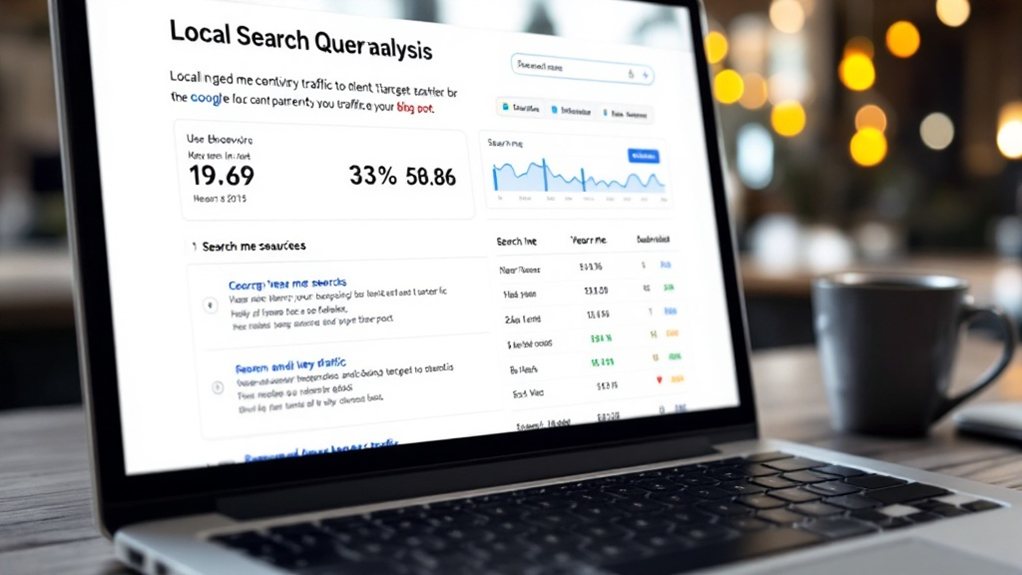To optimize your blog posts for "near me" keywords, start by conducting comprehensive keyword research to uncover relevant local terms and long-tail variations. Incorporate these keywords into your title tags, meta descriptions, header structure, and image alt text to boost your local search visibility. Don't forget to monitor performance and refine your strategies accordingly. By strategically optimizing your content, you can attract more local customers and drive in-store visits. Want to learn more about advanced techniques?
Understand the Importance of 'Near Me' Searches

As online search behavior continues to evolve, understanding the importance of "near me" searches has become crucial for businesses and marketers. The staggering 500% increase in "near me" searches over recent years, coupled with the 200% growth in "shopping near me" searches, underscores the high demand for local information. Moreover, over 84% of these searches are conducted on mobile devices, highlighting the need for optimized mobile experiences. With 28% of "near me" searches leading to a purchase and over 50% resulting in an in-store visit, it's clear that these searches have a significant impact on local businesses and the broader market. Near me searches account for 46% of all Google searches, indicating the critical role they play in local search marketing.
Conduct Comprehensive Keyword Research

To optimize your blog posts for 'near me' keywords, you'll need to identify primary keywords related to your business and location. Assessing the intent helps decide the value of the keyword to the business. Then, discover relevant long-tail terms that target more specific user queries. Finally, analyze search volume trends to understand the demand for these keywords over time.
Identify Primary Keywords
Why is identifying primary keywords through comprehensive keyword research so crucial? Primary keywords form the foundation of your content strategy, guiding the creation of relevant and valuable material. By deeply understanding your audience's search intent and behavior, you can uncover the most impactful terms to target. Keyword research helps bloggers think in terms of their target audience and what they are looking for.
| Keyword Research Benefits | Description |
|---|---|
| Audience Insights | Reveal what users are searching for |
| Content Optimization | Inform on-page SEO and topic coverage |
| Competitive Edge | Identify under-utilized opportunities |
Leverage specialized tools, analyze search volumes and competition, and continuously iterate your primary keyword list. This strategic approach ensures your blog posts connect with the right people at the right time, maximizing your chances of ranking and driving meaningful traffic.
Discover Relevant Long-Tail Terms
Conducting comprehensive keyword research is pivotal when targeting 'near me' keywords. Utilize tools like Ahrefs, Google Keyword Planner, and SEMrush to uncover valuable long-tail terms. Over 70% of search queries use long tail keywords, so understanding user intent, whether it's location-specific, informational, or transactional, is key. Analyze your competitors' keyword strategies to identify gaps and opportunities. Incorporate long-tail terms in your content to improve SERP rankings and boost conversion rates. Regularly refine your keywords based on performance metrics tracked through Google Search Console. Aligning your keywords with emerging trends will future-proof your SEO strategies. Optimizing your blog posts for 'near me' keywords requires diligent, data-driven keyword research.
Analyze Search Volume Trends
When conducting keyword research for "near me" terms, analyzing search volume trends is crucial. Google reports significant growth in these types of queries, with local and organic searches accounting for 69% of overall digital traffic. Searches like "shopping near me" have seen over a 100% increase, indicating higher engagement and conversion rates for local businesses. To leverage this data, you can:
- Use Google Keyword Planner and SEO tools to assess keyword difficulty and volume.
- Analyze competitors' strategies to identify gaps and optimize your own content.
- Focus on location-specific keywords that reflect your target audience's search behavior.
- Naturally incorporate "near me" keywords throughout your blog posts to improve SEO effectiveness.
Monitoring and updating citations as business information changes is also important to ensure consistent NAP (Name, Address, Phone Number) across all online listings.
Optimize Title Tags for Local Relevance

Optimize your title tags to boost local relevance. Title tags are a small ranking factor in Google's search algorithms. Include location-specific keywords and your business name to make your content more appealing to nearby searchers. Structure your titles effectively to ensure essential information is visible and engaging.
Leverage Location Keywords
As you optimize your blog posts for local relevance, don't overlook the power of leveraging location-based keywords in your title tags. Strategically incorporating your target locations can significantly boost your visibility in local search results. Consider these four techniques:
- Identify your key service areas and use specific city or neighborhood names in your title tags.
- Combine your products/services with location modifiers, like "Plumber in Seattle" or "Hair Salon in Downtown Portland".
- Research local language, slang, or landmarks to make your title tags more authentic and relatable.
- Monitor search performance and refine your location-based keywords based on audience behavior.
Incorporate Business Name
Incorporating your business name into the title tags can bolster your local SEO efforts. Your business name in the title reinforces brand identity, distinguishes you among local results, and improves recognition over time. Title tag optimization is a good starting point for local SEO. However, prioritize primary keywords over the business name, ensuring it doesn't overshadow relevant terms. Use modifiers and descriptors to create an appealing title tag. Consider character limits, as Google typically displays 50-60 characters. Place keywords at the beginning for maximum visibility. Analyze title tag performance using SEO tools, and avoid keyword stuffing.
| Benefit | Impact |
|---|---|
| Brand Identity | Reinforces brand recognition |
| Local Distinction | Helps stand out in local search |
| Keyword Balance | Ensure relevance over brand name |
| Optimal Length | Aim for 50-60 characters |
| Analyze Performance | Use SEO tools for optimization |
Optimize Title Structure
Crafting effective title tags is crucial for bolstering your local SEO strategy. Place your primary keyword at the beginning of the title to ensure maximum visibility. Format your title using a structure like "Keyword | Product/Service | Location" to showcase relevance. Additionally, include your city or neighborhood to amplify local appeal. Avoid keyword stuffing, as this can hinder your search engine optimization efforts. Leverage hyper-local keywords to increase the relevance of your content to local users.
- Leverage hyper-local keywords
- Craft persuasive titles for users
- Maintain content-title alignment
- Regularly update titles as trends evolve
Craft Compelling Meta Descriptions
Meta descriptions are a crucial component of your blog post optimization strategy. Keep them concise, around 160 characters or fewer, to avoid truncation in search results. Include your target keyword or a close variation, but don't stuff them. Write in a natural, conversational tone that entices readers to click. Focus on the benefits of your content and use action-oriented language. While meta descriptions don't directly impact rankings, optimizing them can improve click-through rates and establish trust with potential readers. Integrate "near me" keywords seamlessly to attract local searches. Regularly test and update your meta descriptions to ensure they're effectively driving traffic to your blog posts.
Utilize Header Tags Strategically
Now that you've mastered the art of crafting compelling meta descriptions, it's time to take your blog post optimization to the next level by utilizing header tags strategically. Structuring your content with a logical hierarchy of headers – H1, H2, H3, and H4 – helps both users and search engines understand the page's organization. Be sure to:
- Incorporate "near me" keywords into your H1 tag.
- Use long-tail variations of "near me" keywords in H2 and H3 tags.
- Ensure each header clearly describes the following content.
- Maintain a consistent header structure to boost SEO performance.
Strategically leveraging header tags can enhance your blog post's visibility, user experience, and overall search engine optimization.
Incorporate Internal Linking Effectively
Effective internal linking enhances user experience and helps search engines understand your website's structure. Proper internal linking can lead to better search engine rankings by strengthening your site's authority. Use relevant and descriptive anchor text for links and ensure a logical URL structure to facilitate easier navigation. Utilize plugins or tools to manage and optimize internal links efficiently. Build an internal linking hierarchy that reflects your site's structure, and establish topic clusters to deepen the understanding of a subject. Balance internal and external links, fix broken links regularly, and audit your internal links to ensure consistency. Monitor site analytics to track the impact of internal linking on engagement metrics.
Optimize Images With Location-Based Alt Text
Building on the importance of effective internal linking, optimizing your images with location-based alt text can further enhance your blog's visibility in "near me" searches. Describe your images contextually by using alt text that accurately reflects the location. Keep your alt text concise, under 125 characters, and avoid starting with "image of." This not only helps screen readers but also supports faster page loading and improved accessibility. Additionally, incorporating location-specific keywords in your alt text can:
- Increase relevance for local search queries
- Improve visibility in image search results
- Provide valuable context for search engines
- Boost your overall page ranking through relevant signals
Create Location-Specific Content Pages
To further enhance your blog's local search visibility, you should create location-specific content pages. Incorporate local keywords, landmarks, and community involvement to build credibility. Use clear, descriptive titles and subheadings to guide users. Organize key details in bullet points for easy scanning. Ensure content addresses the specific needs of local users, and maintain a consistent tone. Feature geographic-specific customer reviews and use action-oriented language to encourage engagement. Target neighborhood-specific keywords, link between relevant local pages, and avoid duplicate content. Create separate pages for each location and use unique, creative content to differentiate them. Mention the history of your business in specific locations to build local identity.
Leverage Schema Markup and Maps
Leveraging schema markup and maps can significantly boost your blog's local search visibility. By implementing the right schema types, like LocalBusiness, you can showcase crucial details about your business, such as your name, address, phone number, hours, and location. This structured data helps search engines better understand your content, increasing your chances of appearing in rich snippets and local packs. Additionally, schema markup can aid in:
- Displaying your business on relevant maps for nearby searches.
- Integrating customer reviews to build trust and credibility.
- Streamlining navigation links for your local pages.
- Enhancing your knowledge panel information on search results.
Optimizing your blog with schema and maps can drive more qualified local traffic and improve your overall search engine performance.
Monitor Performance and Refine Strategies
Once you've implemented schema markup and leveraged maps to boost your local search visibility, it's essential to monitor your performance and continuously refine your strategies. Track your local pack rankings, organic search rankings, website traffic, Google Business Profile insights, and conversion rates to identify areas for improvement. Utilize keyword research tools, optimize meta descriptions and headers, and ensure content relevance for "near me" searches. Segment your data, review reports, conduct A/B testing, and integrate social media to enhance your local SEO efforts. Consistently monitor your SEO score, analyze competitor strategies, and implement actionable recommendations to stay ahead of the curve.
| Metric | Tool |
|---|---|
| Local Pack Rankings | Google Search Console |
| Organic Search Rankings | Moz, Local Falcon |
| Website Traffic | Google Analytics |
| Business Profile Insights | Google Business Profile |
| Conversion Rates | Google Analytics |
